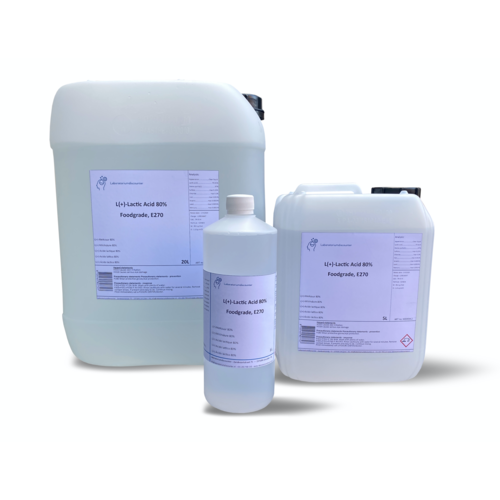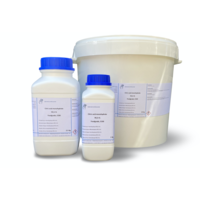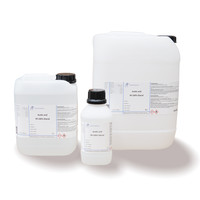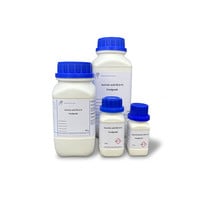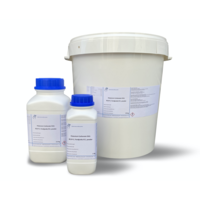You have no items in your shopping cart
(+)-Lactic acid 80%, food grade, E270
- Buy 2 and save 5%
- Buy 6 and save 10%
What is Lactic Acid?
Lactic acid is a hydroxycarboxylic acid, so it contains both a carboxyl group and a hydroxyl group. It is therefore also referred to as 2-hydroxypropionic acid, but according to IUPAC nomenclature recommendations, the name 2-hydroxypropionic acid should be used. The salts and esters of lactic acid are called lactates.
What is Lactic Acid used for?
-Power supply
A number of foods are made directly through lactic acid fermentation. This mainly includes sour milk products such as sour milk, yogurt, kefir and buttermilk. These are produced by infecting pasteurized milk with starter cultures of lactic acid bacteria. Other products include lacto-fermented vegetables such as sauerkraut, beetroot in some varieties of borscht, or kimchi, as well as sourdough and sourdough products. Silage, fresh feed made sustainable by fermentation, is also based on lactic acid fermentation.
As a food additive, lactic acid carries the designation E 270. It is used in many different ways as an acidity regulator in the food and luxury goods industries, for example in baked goods, confectionery and occasionally in lemonades. By changing the pH value in the food to a pH of about 4, the food is preserved, since colonization with other microorganisms is largely excluded.
In the form of the salts calcium lactate or calcium lactate gluconate it can also be added for calcium enrichment.
Material use
Lactic acid is the monomer of polylactides or polylactic acids (PLA), which are used in various ways as biodegradable and biobased plastics.
Lactic acid has an antibacterial effect and is therefore added to liquid soaps, cleaners and detergents. They develop their disinfecting effect optimally at a pH value of 3 to 4. It was and is also used as a contraceptive.
Lactic acid is used as a descaling agent in the tannery for descaling hides. It is also used for this purpose in the textile industry and printing companies. Some cleaning tablets for coffee machines, soft drinks machines and similar appliances contain lactic acid as a descaling agent.
Beekeepers use lactic acid to treat bees against the Varroa mite, ensuring that the treated hives or honeycombs are brood free. Arachnologists use lactic acid to illuminate the prepared epigyne of female spiders or other chitin structures and to dissolve tissue debris.
Pharmaceutical technology uses lactic acid to convert water-insoluble medicinal substances into salts of lactic acid (lactates); these are more soluble in water (example: ciprofloxacin).
In cosmetics, lactic acid is used in skin creams and other products to treat acne.
Buy lactic acid?
Are you looking for Foodgrade Lactic Acid? Then you have come to the right place at Laboratorydiscounter! The purest lactic acid that is food grade certified for a friendly price. Lactic acid for a friendly price and available in different packaging! Always with volume discount.
Technical data:
Sarcolactic acid, Lactol, 2-Hydroxypropionic acid
Empirical formula C3H6O3
Molar mass (M) 90,1 g/mol
Density (D) 1,22 g/cm³
Boiling point (bp) 122 °C
Flash point (flp) 113 °C
WGK 1
CAS No. [79-33-4]
EG-Nr. 201-196-2
Downloads
$$$$$
Hazard Statements
H315 Causes skin irritation.
H318 Causes serious eye damage.
Precautions - prevention
P280 Wear protective gloves/eye protection.
Precautions - response
P302+P352 IF ON SKIN: Wash with plenty of water.
P305+P351+P338 IF IN EYES: Rinse cautiously with water for an
amount of minutes; remove contact lenses, if possible; keep rinsing.
P310 Immediately call a POISON CENTER/doctor.


